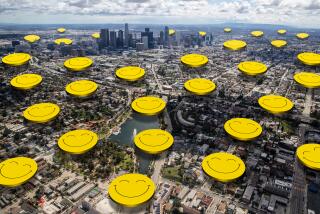Sitting on a Sedona Vortex, She Feels All Too in Touch With Earth
My first impression of Sedona was that this peculiar little Arizona town, halfway between Phoenix and the Grand Canyon, shouldn’t be a town at all. With its towering red rock formations, hoodoos, buttes and spires rising out of the crimson earth into sapphire skies and its canyons and mountain forests of pinyon and juniper, Sedona is entirely too majestic for people to actually live there.
Yet as I drove through Sedona’s landscaped neighborhoods of adobe homes and passed the trendy restaurants and outdoor cafes where tourists and townsfolk basked in views of the spectacular landscape, I realized I was just jealous. Shouldn’t people sometimes be allowed to live in paradise?
My enthusiasm wilted when I discovered that the beauty of the land wasn’t the only reason tourists flock to Sedona at the rate of 4 million a year. Sedona also happens to be the New Age Mecca, or the New Age Tourist Trap, depending on your astrological sign. Sedona attracts healers, psychics, channelers and mystics from all over the world. Among the topics in the New Age magazine Sedona, Journal of Emergence, last spring: “The World Through My Dog’s Sacred Vision,” “The Eleventh Chakra in the Fourth Dimension,” “Channeling for Beginners” and my favorite, “Could It Be You’re Already Dead?”
The Native Americans were the first to identify the Sedona area as a place of unusual energy. They considered certain parts of the land sacred--as do many of today’s New Agers who are drawn to Sedona’s “vortexes.” These supposedly are focal points in Earth’s natural energy grid, places where energy enters and leaves the planet. Psychic powers, emotions and talents are stronger in Sedona, it is claimed. I’ve heard that some people move to Sedona expecting to enjoy the heightened energy and find it so intense they have to leave.
I’d first heard about Sedona during a talk at a bookstore in Berkeley when the speaker mentioned “Sedona, which as you know is the essential American sacred site.” I didn’t know that, but most of the audience did because they nodded their heads in enthusiastic agreement.
A few months later I heard more about it while on a camping trip with my fiance. We stopped at Verde Hot Springs, about 20 miles south of Sedona. The campground hippies, who seemed to be living there permanently, had bizarre stories to tell in support of Sedona’s mystical reputation.
One offered his expertise on Sedona’s four main vortexes and what each of their “sacred energies” does: One vortex takes something away from you that you want but gives you back something you need, kind of like the Rolling Stones song. Another vortex overwhelms you with so much energy you might get sick; another one puts you to sleep; another strips you of your beliefs. I smiled and nodded politely, pretending I didn’t think him a flake.
I was skeptical, to say the least, even when Rob and I drove up for a look at the U.S. capital of the metaphysical. In less than a half-hour of walking around, it was clear that Sedona was entirely different from other colorful Arizona towns I’d visited, places like Bisbee and Patagonia, small old-fashioned towns with real main streets and real people who work at real jobs. But perhaps, I reflected, it’s only right that oddballs have their own town.
We stopped, naturally, in the Center for the New Age, a serene little shop full of crystals, fountains, tarot cards, flute music and dreamy-eyed patrons. On the bulletin board, April White Cloud advertised her services as a master clairvoyant, psychic healer and shaman priestess. I wasn’t fooled for a minute. Nor did I fall for the man in the glossy photo who was dressed in a flowing white cotton number, silver bracelets and a gray ponytail. He offered to open one’s “third eye,” retrieve wandering souls and channel spirits for $100 a session.
All the talk about altered states and parallel universes was a turnoff, but then I found what I was looking for: the store’s vortex corner, where a woman in her 50s sat smiling like a Buddha. She was friendly and talkative, much friendlier than the man at the tourist information station, who frowned when I asked about hiking to the vortexes and tried to tell me the trails were too muddy to hike.
The vortex woman--like me, a transplant from Canada--sketched out the basics of vortex science: There are two types of energies coming from the rocks, magnetic (female) and electric (male). “Boynton Canyon has both,” she said. “It’s balanced, so you’ll notice the people there are calm. There’s no male-female tension in Boynton Canyon.”
As for the three other sites, she said Cathedral Rock was magnetic and therefore feminine. The energy at Bell Rock is so powerful I would notice it even before I got out of my car. The Airport Vortex is masculine, “so watch out.”
She recommended that I go on a guided trek because guides are on a higher level of spiritual consciousness, so those they lead have a more powerful experience.
At $250 for both of us, I figured Rob and I could find the vortexes on our own and maybe eavesdrop on a guided tour and let the leftover sacred energy spill onto us.
As I left, the vortex woman called after me not to worry about going guideless because a person would have to be abnormally insensitive not to feel anything.
Sacred energy of Earth, come and get me....
In the morning, Rob and I began our five-mile hike through Boynton Canyon. In the first half-hour we encountered dozens of hikers, most of them in couples. Judging from the crabbiness I overheard, I figured we were a long way from the vortex’s soothing influence.
The farther we hiked, the fewer hikers there were, so the more we stopped to chat with those we passed. Toward the end of the trail, high up in a spectacular box canyon, the first question we asked of our fellow hikers was always, “Do you feel anything?” Common replies were along the line of, “Yeah, my legs hurt.” No one seemed to have found the vortex.
After we had hiked the whole five miles and were back at our van, we met a young man who gave us a vortex map, more detailed than mine, and discovered that Boynton Canyon’s vortex is just 50 yards from the parking lot.
I sat down in the dusty red dirt to absorb some sacred energy, but all I could feel was the midday sun burning my face.
But I wasn’t deterred. After exploring downtown Sedona, which, like a New Age Disneyland, is full of little shops selling angels, crystals, affirmation cards, tea leaves, tie-dye and mocha ice cream, we headed back to the hills for the sunset.
In red rock country, sunset is an event of dazzling proportions that people anticipate for hours. The last rays of the day ignite the towering rocks like golden castles until finally they burn up in a glowing cayenne blaze. When it’s over, the mountains darken to violet shadows. The sky fills with rose clouds, the air turns cold and the people go home.
We decided to watch the sunset from Airport Vortex because it’s up high and has tremendous views in all directions, all day long. I scrambled up the rocks ahead of Rob, thinking perhaps I would “feel” more on my own. It was a short but steep climb, and on my way up I passed a large middle-aged woman huffing and puffing as she descended. “I didn’t feel anything,” she said to her husband. “What a waste of time that was.” I kept climbing.
At the top, the sun was painting everything a fierce red. For a long time I sat on the sandstone and stared out across the dizzying grandeur of the high desert landscape, the mesas, mountains and buttes, trying to probe the depths of my inner self, yearning for Earth’s energy to mingle with my own, and thinking “I could go for a super burrito right now.”
The next day we went to Cathedral Rock, which, with its red spires lofting over Oak Creek, is probably the most photographed site in Sedona. We hiked along the creek until we found Cathedral Rock Vortex, sat down and tried seriously this time to sense the surges of energy. Under the shade of a juniper beside the lively creek, I closed my eyes, took a deep breath and tried to empty my mind. Gradually I began to relax as a soothing calm flowed through me and my thoughts slowed down. The world around me was at peace.
Then I heard something, something stirring and sweet, low murmurs drifting up through the funnels of the red ground straight to my heart. Hallelujah, Mother Earth had finally reached me. The murmurs grew louder, so loud I opened my eyes to see a group of people sitting in a circle across the creek. They were chanting. They were dressed funny too, wearing long black capes and wide-brimmed mauve hats. A moment before, I’d thought I’d just felt God, or somebody like him, and now I just felt crummy.
We got up to leave. How could we feel anything with them babbling away like that? I wanted to call to them across the stream, “Hey, what are you guys feeling over there anyway?” but decided against it.
On our way back we saw a couple in their 60s--portly, friendly and all-American. The man was struggling to cross the stream. He shouted at us, “Hey, where is the dang thing?”
“What,” I said, “the vortex?”
“The what? What’s that?”
“Well, it’s supposed to be ... “
“I’m looking for the photo op,” he interrupted.
As it turned out, the photo op was close by and a far more spectacular and rousing place than the vortex. A flat plain of molten red rocks cooled in wavy shapes millennia ago, it is a perfect spot for picnics. People were eating, drinking wine and enjoying the view. Children laughed at some ducks that seemed to be shooting the rapids in the brook and flying back to shoot them all over again. People threw sticks for dogs, and families snapped pictures. These people were oblivious to the “sacred site” just 10 minutes away but seemed to be having a lot more fun than the murmuring circle of New Age energy channelers.
The fourth of the Sedona vortexes was Bell Rock, also a popular site for UFO sightings, and we stopped there just for the heck of it. I’d given up on the vortexes by then, and I admit I didn’t try very hard to feel anything at Bell Rock. I thought of what someone had said, that the only vortex he noticed in Sedona was the one sucking gas from his car when he sat in traffic for 45 minutes. Was the whole town built on a hoax? How can you have a spiritual moment when it’s expected of you? Aren’t these things meant to happen when we least expect it?
But as I climbed Bell Rock I looked to the west. The sun had just fallen behind a mountain, and its afterglow was orchestrating the sky into swirling masses of mandarin and deep purple. A single planet, perhaps Venus, winked down to where I stood. A light breeze cooled my arms, pinyons gave off the fragrance of their oozing gum, and coyotes howled for night to begin. Inside I was quietly exploding from the beauty around me. This is Earth’s energy, I realized, and this is sacred.
More to Read
Sign up for The Wild
We’ll help you find the best places to hike, bike and run, as well as the perfect silent spots for meditation and yoga.
You may occasionally receive promotional content from the Los Angeles Times.






